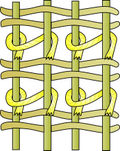Pile is the raised surface or nap of a fabric, consisting of upright loops or strands of yarn.[1] Examples of pile textiles are carpets, corduroy, velvet, plush, and Turkish towels.[2] The word is derived from Latin pilus for "hair".[3]
Length and density[edit]
The surface and the yarn in these fabrics are also called "pile". In particular "pile length" or "pile depth" refer to the length of the yarn strands (half-length of the loops). Pile length affects and is affected by knot density: "The greater the knot density, the thinner the weft and warp yarns and the more weakly are they twisted; the smaller the density, the coarser are the foundation yarns."[4] Designs and motifs are also affected by and affect pile depth: "A carpet design with a high knot density is better adapted to intricate and curvilinear designs, which of necessity must have a shorter pile length to avoid looking blurry. A carpet with a lesser knot density is better adapted to bold, geometric designs and can utilize a long pile for softer, more reflective surface that appeals to the sense of touch."[5]
Types[edit]
- Loop
- Uncut
- Cut
- Knotted
- Tufted
- Woven
- Cord
- Twist
See also[edit]
References[edit]
- ^ "Pile." The Oxford English Dictionary. 2nd ed. 1989.
- ^ "pile", Dictionary.com Unabridged (v 1.1). Random House, Inc. Retrieved 10 September 2007.
- ^ "Pile," Online Etymology Dictionary. Douglas Harper, Historian. retrieved from dictionary.com 10 September 2007.
- ^ Tzareva, Elena (1984). Rugs & carpets from Central Asia: the Russian collections, p.12-3. Penguin. ISBN 9780140063691.
- ^ Denny, Walter B. (2014). How to Read Islamic Carpets, p.43 & 61. Metropolitan Museum of Art. ISBN 9780300208092.

